
Castlefield is an inner-city conservation area in Manchester, North West England. The conservation area which bears its name is bounded by the River Irwell, Quay Street, Deansgate and Chester Road. It was the site of the Roman era fort of Mamucium or Mancunium which gave its name to Manchester. It was the terminus of the Bridgewater Canal, the world's first industrial canal, built in 1764; the oldest canal warehouse opened in 1779. The world's first passenger railway terminated here in 1830, at Liverpool Road railway station and the first railway warehouse opened here in 1831.

Centenary Square is a public square on the north side of Broad Street in Birmingham, England, named in 1989 to commemorate the centenary of Birmingham achieving city status. The area was an industrial area of small workshops and canal wharves before it was purchased by the council in the 1920s for the creation of a grand civic centre scheme to include museums, council offices, cathedral and opera house. The scheme was abandoned after the arrival of World War II with only the Hall of Memory and half of the planned Baskerville House complete. After the war the scheme was revived in a simpler form however the council never managed to implement the design.

The Oxo Tower is a building with a prominent tower on the south bank of the River Thames in London. The building has mixed use as Oxo Tower Wharf containing a set of design, arts and crafts shops on the ground and first floors with two galleries, Bargehouse and gallery@oxo. The Oxo Tower Restaurant, Bar and Brasserie is on the eighth floor, which is the roof-top level with fine and casual dining. In addition to this, situated on the eighth floor is a viewing gallery open to the public. The third to seventh floors contain 78 flats owned by Redwood Housing. Much of the second floor can be hired out for events and weddings.

Trinity Buoy Wharf is the site of a lighthouse, by the confluence of the River Thames and Bow Creek on the Leamouth Peninsula, Poplar. It lies within the London Borough of Tower Hamlets. The lighthouse no longer functions, but is the home of various art projects such as Longplayer. It is sometimes known as Bow Creek Lighthouse.
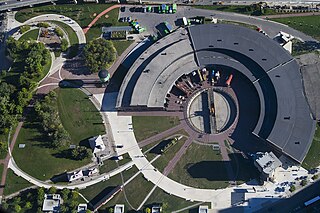
A railway roundhouse is a building with a circular or semicircular shape used by railways for servicing and storing locomotives. Traditionally, though not always the case today, these buildings surrounded or were adjacent to a turntable.
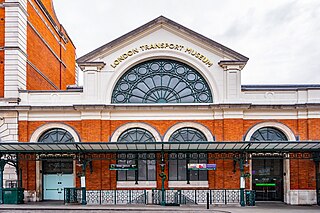
The London Transport Museum (LTM) is a transport museum based in Covent Garden, London. The museum predominantly hosts exhibits relating to the heritage of London's transport, as well as conserving and explaining the history of it. The majority of the museum's exhibits originated in the collections of London Transport, but, since the creation of Transport for London (TfL) in 2000, the remit of the museum has expanded to cover all aspects of transport in the city and in some instances beyond.

Birmingham Curzon Street railway station was a railway station in central Birmingham, England. Initially used as a major early passenger terminus before being eclipsed by newer facilities and converted into a goods depot, it was a continuously active railway facility up until 1966.

Edgbaston Reservoir, originally known as Rotton Park Reservoir and referred to in some early maps as Rock Pool Reservoir, is a canal feeder reservoir in Birmingham, England, maintained by the Canal & River Trust. It is situated close to Birmingham City Centre and is a Site of Importance for Nature Conservation.

The River Cam is a small river in Gloucestershire, England. It flows for 12 miles (20 km) north-westwards from the Cotswold Edge, across the Vale of Berkeley, into the Gloucester and Sharpness Canal.
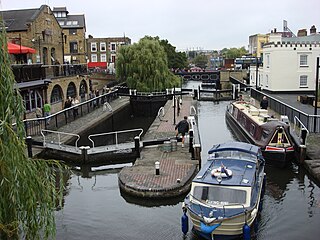
Camden Lock is a small part of Camden Town, London Borough of Camden, England, which was formerly a wharf with stables on the Regent's Canal. It is immediately to the north of Hampstead Road Locks, a twin manually operated lock. The twin locks together are "Hampstead Road Lock 1"; each bears a sign so marked. Hawley Lock and Kentish Town Lock are a short distance away to the east; to the west is a long level pound — it is 27 miles (43 km) to the next lock.
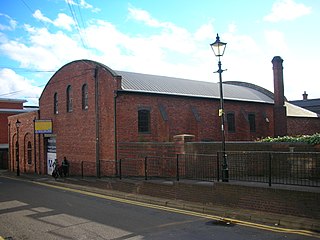
The Gas Retort House at 39 Gas Street, Birmingham, England is the last remaining building of Birmingham's first gas works.

The Crescent Theatre is a multi-venue theatre run mostly by volunteers in Birmingham City Centre. It is part of the Brindleyplace development on Sheepcote Street. It has a resident company, one of the oldest theatre companies in the city, and also hires its three performance spaces to a host of visitors each year, nationally and internationally, both amateur and professional.
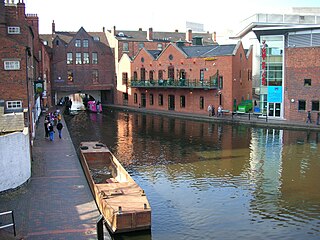
Gas Street Basin is a canal basin in the centre of Birmingham, England, where the Worcester and Birmingham Canal meets the BCN Main Line. It is located on Gas Street, off Broad Street, and between the Mailbox and Brindleyplace canal-side developments.

Apperley Bridge is a village in the metropolitan borough of the City of Bradford, in West Yorkshire, England in the Idle and Thackley Ward. Apperley Bridge is north-east of Bradford on the boundary with the City of Leeds bounded in the east by Carr Beck and to the south by Greengates. The village straddles the Leeds and Liverpool Canal and the River Aire. It takes its name from the old bridge over the river on Apperley Lane.
This article is intended to show a timeline of events in the History of Birmingham, England, with a particular focus on the events, people or places that are covered in Wikipedia articles.

The Georgia State Railroad Museum is a museum in Savannah, Georgia located at a historic Central of Georgia Railway site. It includes parts of the Central of Georgia Railway: Savannah Shops and Terminal Facilities National Historic Landmark District. The complex is considered the most complete antebellum railroad complex in the United States. The museum, located at 655 Louisville Road, is part of a historic district included in the National Register of Historic Places.

Birmingham Curzon Street railway station is the planned northern terminus of High Speed 2 on the fringe of Birmingham city centre, England. The new railway will connect Birmingham to London Euston via Birmingham Interchange and Old Oak Common. Curzon Street will have seven terminal platforms and is planned to open in 2026.
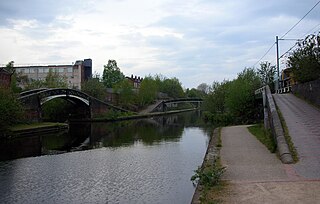
The Icknield Port Loop is a 0.6-mile (1 km) loop of the eighteenth-century-built Old BCN Main Line canal in Birmingham, England, about 2 miles (3 km) west of the city centre, which opened to traffic on 6 November 1769 and in some definitions includes its straighter bypass built in September 1827, a 550-yard (500 m) section of the New BCN Main Line. Most of the 56 acres (23 ha) of land thereby enclosed is derelict meaning the canal serves the Canal & River Trust maintenance depot at Icknield Port and conveys water from Edgbaston Reservoir to the BCN Main Line. The enclosed land has no pedestrian or vehicular access. Icknield Port (Loop) takes its name from the Roman Icknield Street which passed nearby, the exact route of which is unknown.

The Canal & River Trust (CRT), branded as Glandŵr Cymru in Wales, holds the guardianship of 2,000 miles of canals and rivers, together with reservoirs and a wide range of heritage buildings and structures, in England and Wales. Launched on 12 July 2012, the Trust took over the responsibilities of the state-owned British Waterways in those two places.

The Crescent was a part-completed Regency-style terrace in central Birmingham, England. The scheme was first proposed in 1788, construction started in 1795 and was discontinued the same year. The partially-completed terrace was finally demolished in the mid- to late 1960s. Like other late 18th and early 19th century crescent terraces in Britain and Ireland, it took its inspiration from The Crescent, Bath, designed by John Wood the Younger and built 1767 to 1774.




















